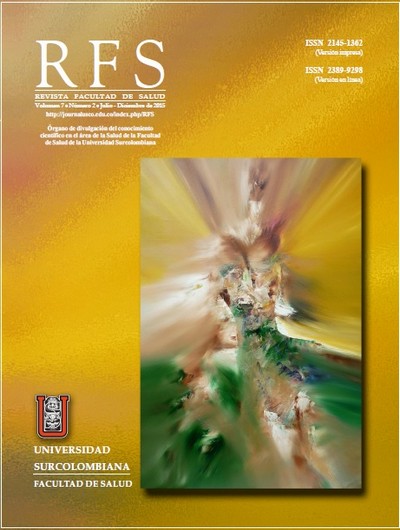Gastric cancer: epidemiological, clinical and pathological characteristics of patients treated in the university hospital of Neiva, between january 2007 and december 2012
##plugins.themes.bootstrap3.article.main##
Gastric cancer is the second leading cause o f death in the world from a malignant disease and is most commonly diagnosed at an advanced stage with high incidence and prevalence rates. Method. A descriptive, observational study was carried out with the aim of studying the epidemiological, clinical and pathological variables in patients with gastric cancer in the University Hospital of Neiva between January 2007 and December 2012. The study examined histological type and demographic, clinical, diagnostic and treatment variables. Results. The study found 396 patients with gastric adenocarcinoma, occurring more frequently in men, with a male to female ratio of 2:1 (the average age was 59.7), 85% came from the department of Huila, Neiva being the most common municipality. The main symptom was epigastralgia (59.35%), followed by weight loss (46.38%). The most common histological type in men was intestinal (49.6%) and diffuse in women (36.9%). The gastric adenocarcinoma was more com m only found in the distal third , in 222 patients (56.6%). The most widely used diagnostic method was the gastric biopsy (89.4%). The disease was detected at advanced stage III in 85 patients (21.5%) and at stage IV in 19 (37.6%). 167 patients (42.2%) died, the oncological disease was the cause of death in 97. Conclusions. Gastric cancer is a pathology with high incidence and prevalence rates in the department of Huila. The University Hospital of Neiva is a point of reference for patients and therefore must continue developing strategies to improve early detection and carry out a prospective study in order to identify and characterise the risk factors of the development of gastric cancer.
Downloads
##plugins.themes.bootstrap3.article.details##
Japanese Gastric Cancer Association. Japanese classification of gastric carcinoma: 3rd English edition Gastric Cancer. 2011 Jun;14(2):101-12.
Rotterdam H. Carcinoma of the stomach. In: Rotterdam H, Enterline HT. Pathology of the stomach and duodenum. New York: Springer-Verlag, 1989:142-204.
Dicken BJ, Bigam DL, Cass C, Mackey JR, Joy AA, Hamilton SM. Gastric adenocarcinoma: review and considerations for future directions. Ann Surg 2005;241:27-39.
World Health Organization. GLOBOCAN 2012: Estimated Cancer Incidence, Mortality and Prevalence Worldwide [Internet]. Lyon, France: International Agency for Research on Cancer; 2012 [cited 2015 Oct 8]. Available from: http://globocan.iarc.fr/Pages/fact_ sheets_population.aspx
Pardo C, Cendales R. Incidencia estimada y mortalidad por cáncer en Colombia, 2002-2006. Bogotá; INC: 2010.
Pardo C, Cendales R. Incidencia mortalidad y prevalencia de cáncer en Colombia, 2007-2011. Bogotá; INC:2015.
Murillo R, Piñeros M, Suárez G, Garríos A, Pozo H. Atlas de mortalidad por cáncer de Colombia. Santa Fe de Bogotá: Instituto Nacional de Cancerología; 2003.
Bonequi P, Meneses-González F, Correa P, Rabkin CS, Camargo MC. Risk factors for gastric cancer in Latin America: a meta-analysis. Cancer Causes Control. 2013 Feb;24(2):217-31.
Tokunaga M, Land CE, Uemura Y, et al. Epstein-Barr virus in gastric carcinoma. Am J Pathol. 1993;143:1250- 1254.
Guilford P, Hopkins J, Harraway J, McLeod M, McLeod N, Harawira P, Taite H, Scoular R, Miller A, Reeve AE. Ecadherin germline mutations in familial gastric cancer. Nature. 1998 Mar 26;392(6674):402-5
Camargo MC, Mera R, Correa P, Peek RM Jr, Fontham ET, Goodman KJ, Piazuelo MB, Sicinschi L, Zabaleta J, Schneider BG. Interleukin-1beta and interleukin-1 receptor antagonist gene polymorphisms and gastric cancer: a meta-analysis. Cancer Epidemiol Biomarkers Prev. 2006 Sep;15(9):1674-87.
Jensen OM, Parkin DM, MacLennan R, Muir CS, Skeet RG. El registro hospitalario de cáncer. En: Registros de cáncer: principios y métodos.
Pardo C, Guzmán J, Rodríguez O. Cáncer en la Unidad de Cancerología de Huila, 2006-2008 Rev Colomb Cancerol. 2013;17(2):62-68
Schwartz G. Invasion and metastasis in gastric cancer: in vitro and in vivo models with clinical considerations. Semin Oncol. 1996;23:316-324.
Hernán Espejo Romero H, Navarrete J. Clasificación de los Adenocarcinomas de estómago Rev Gastroenterol Perú 2003;23:199-212.
Bermúdez Carlos, Insuasty Jesús, Gamarra Germán. Grupo sanguíneo A y riesgo de cáncer gástrico en el Hospital Universitario de Santander (Bucaramanga, Colombia). Acta Med Colomb. 2006 Dec; 31(4):400-410.
Qiu MZ, Cai MY, Zhang DS, Wang ZQ, Wang DS, Li YH, Xu RH. Clinicopathological characteristics and prognostic analysis of Lauren classification in gastric adenocarcinoma in China. J Transl Med. 2013 Mar 6;11:58. doi: 10.1186/1479-5876-11-58.
Stiekema J, Cats A, Kuijpers A, van Coevorden F, Boot H, Jansen EP, Verheij M, Balague Ponz O, Hauptmann M, van Sandick JW. Surgical treatment results of intestinal and diffuse type gastric cancer. Implications for a differentiated therapeutic approach?Eur J Surg Oncol. 2013 Jul;39(7):686-93. doi: 10.1016/j.ejso.2013.02.026. Epub 2013 Mar 15.
Digklia A, Wagner AD. Advanced gastric cancer: Current treatment landscape and future perspectives. World J Gastroenterol. 2016 Feb 28;22(8):2403-14.










